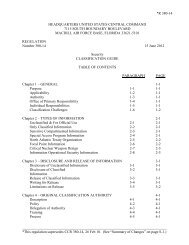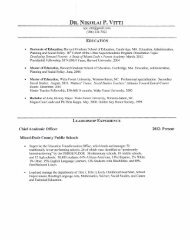extracts-studies-dec-2016
extracts-studies-dec-2016
extracts-studies-dec-2016
You also want an ePaper? Increase the reach of your titles
YUMPU automatically turns print PDFs into web optimized ePapers that Google loves.
Intelligence in Public Media<br />
The Field of Fight: How We Can Win The Global War Against Radical Islam and Its Allies<br />
Lt. Gen. Michael T. Flynn with Michael Ledeen (St. Martin’s Press,<br />
<strong>2016</strong>), 180 pp., notes, suggested reading, index.<br />
The Pivot: The Future of American Statecraft in Asia<br />
Kurt Campbell (Twelve—Hachette Book Group, <strong>2016</strong>), 349 pp., notes, bibliography, index.<br />
Reviewed by Jason U. Manosevitz<br />
Presidential election years often breed several national<br />
security-related books. These works can give insight into<br />
the substantive security issues at stake and help intelligence<br />
professionals prepare to serve the next administration.<br />
This time in particular, two books lay out competing<br />
objectives that will feed into how the Intelligence Community<br />
(IC) prioritizes its resources in support of the next<br />
administration.<br />
Lt. Gen. (Ret.) Michael T. Flynn’s The Field of Fight:<br />
How to Win The Global War Against Radical Islam<br />
and Its Allies, co-written by Michael Ledeen, and Kurt<br />
Campbell’s The Pivot: The Future of American Statecraft<br />
in Asia, lay out starkly contrasting strategies for dealing<br />
with counterterrorism and the rise of China, respectively.<br />
As long-serving national security professionals, Flynn<br />
and Campbell’s works highlight two issues intelligence<br />
professionals will need to continue to address through<br />
collection, operations, and analysis. Each makes an<br />
impassioned case for prioritizing his area of interest and<br />
calls for whole-of-government approaches. Both fall<br />
short, however, by not articulating how the IC fits into<br />
their strategies and by failing to consider the key premises<br />
underlying their recommended courses of action and the<br />
implications.<br />
The Field of Fight and The Pivot also serve to remind<br />
intelligence professionals how difficult it can be to array<br />
intelligence resources against different kinds of national<br />
security issues. The Field of Fight focuses on our immediate<br />
counterterrorism fight, a functional intelligence<br />
issue like counternarcotics, counterproliferation, cyber<br />
activities, and illicit finance. Such issues transcend specific<br />
states or geographic regions. In contrast, The Pivot<br />
addresses the implications of an emerging threat stemming<br />
from an assertive China and its effect on East Asia’s<br />
security dynamics—a regional, state-based issue.<br />
The Field of Fight demands the fight against terrorism<br />
be recast as a struggle against what Flynn calls “radical<br />
Islam.” Flynn, who led the Defense Intelligence Agency<br />
from July 2012 to August 2014, castigates the Obama<br />
administration for lacking the will to fight ISIL and losing<br />
the broader initiative against terrorism. Flynn argues his<br />
unique experiences—many of which come from his combat<br />
tours in Afghanistan and Iraq, and his tours with the<br />
Joint Special Operations Command—allow him to “get<br />
in to the heads of our enemies,” based on many hours he<br />
spent debriefing captured terrorists (11, 50–52). His book<br />
asserts China, Cuba, Iran, North Korea, and Russia are in<br />
an alliance with ISIL and other terrorist groups to destroy<br />
the United States (28, 76–78).<br />
Flynn’s strategy—akin to the thinking behind the<br />
“Global War on Terrorism”—emphasizes a military<br />
solution in black and white terms. He lays out four strategic<br />
objectives: mobilizing all national power under the<br />
command of a single leader accountable to the president;<br />
killing or capturing terrorists wherever they are; compelling<br />
state and non-state supporters of terrorists to end<br />
their activities; and waging an ideological war against<br />
radical Islam. (117–118) Embedded in these objectives<br />
are sub-points that include building up the capabilities<br />
of states that are unable to aid the United States with its<br />
strategy; cutting or curtailing US diplomatic, economic,<br />
and military ties with states that fail to follow international<br />
norms and international law; and improving the use of<br />
social media tools, like Facebook and Twitter, to repudiate<br />
terrorist doctrine. (121–122)<br />
The Field of Fight offers little perspective on US policy<br />
in the Middle East or against counterterrorism, covering<br />
only about the last 15 years of the United States’s<br />
<strong>dec</strong>ades-long history of engagement there. It argues ISIL<br />
presents a severe ideological challenge to democracy, but<br />
All statements of fact, opinion, or analysis expressed in this article are those of the author. Nothing in the article should be construed<br />
as asserting or implying US government endorsement of its factual statements and interpretations.<br />
Studies in Intelligence Vol 60, No. 4 (Extracts, December <strong>2016</strong>)<br />
25




